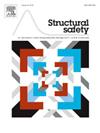Sequential and adaptive probabilistic integration for structural reliability analysis
IF 6.3
1区 工程技术
Q1 ENGINEERING, CIVIL
引用次数: 0
Abstract
We propose the application of sequential and adaptive probabilistic integration (SAPI) to the estimation of the probability of failure in structural reliability. SAPI was originally developed to explore the posterior distribution and estimate its normalising constant in Bayesian model updating. The principle is to perform probabilistic integration on a sequence of distributions, moving from the prior to the posterior, to learn the normalising constant of each distribution. In structural reliability, SAPI can be used to sample an approximation of the optimal importance sampling (IS) density, and we present a particular choice of the intermediate distributions. The derived SAPI estimator is thus an IS estimator of the thought probability. The numerical uncertainty is propagated using random process sampling, and the induced posterior statistics are used to design a Bayesian active learning strategy. Four numerical examples demonstrate that SAPI outperforms other state-of-the-art active learning reliability methods using sequential Monte Carlo samplers.
结构可靠性分析的顺序自适应概率集成
提出了序列自适应概率积分法(SAPI)在结构可靠性失效概率估计中的应用。SAPI最初是为了在贝叶斯模型更新中探索后验分布并估计其归一化常数而开发的。其原理是对一系列分布进行概率积分,从先验到后验,以学习每个分布的归一化常数。在结构可靠性中,SAPI可用于抽样最优重要抽样(IS)密度的近似值,并给出了中间分布的特定选择。因此,导出的SAPI估计量是思想概率的is估计量。采用随机过程抽样方法传播数值不确定性,并利用诱导后验统计量设计贝叶斯主动学习策略。四个数值示例表明,SAPI优于使用顺序蒙特卡罗采样器的其他最先进的主动学习可靠性方法。
本文章由计算机程序翻译,如有差异,请以英文原文为准。
求助全文
约1分钟内获得全文
求助全文
来源期刊

Structural Safety
工程技术-工程:土木
CiteScore
11.30
自引率
8.60%
发文量
67
审稿时长
53 days
期刊介绍:
Structural Safety is an international journal devoted to integrated risk assessment for a wide range of constructed facilities such as buildings, bridges, earth structures, offshore facilities, dams, lifelines and nuclear structural systems. Its purpose is to foster communication about risk and reliability among technical disciplines involved in design and construction, and to enhance the use of risk management in the constructed environment
 求助内容:
求助内容: 应助结果提醒方式:
应助结果提醒方式:


